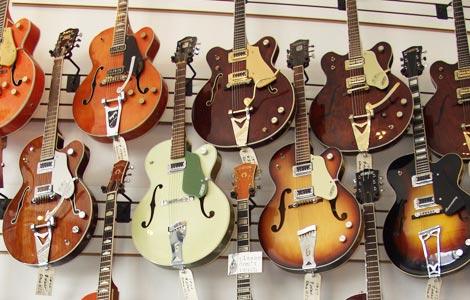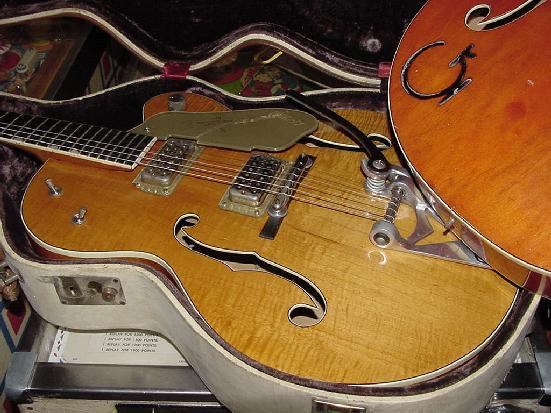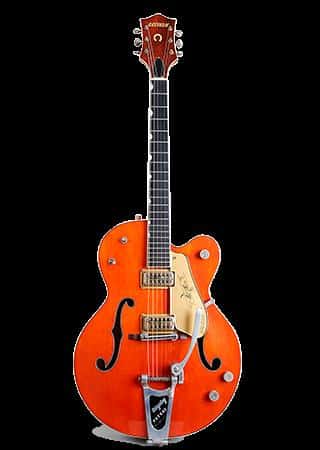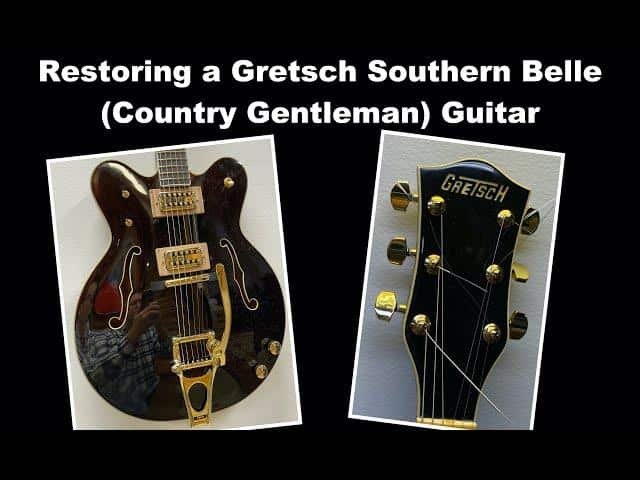I still vividly remember the day the vintage Gretsch guitar came into my possession. Its sun-aged retro charm, those iconic Filter’Tron humbuckers and its hollow-body resonance combined to form an eclectic symphony of decades past, echoing storied legends like Chet Atkins and George Harrison. It’s this enchantment that sparked my lifelong quest, illuminating my path through the vast enchanted forest of Gretsch guitar history.
Why Gretsch, you ask? The answer lies infused in the worn-out frets and scratchy pots. Vintage Gretsch guitars are time capsules, each carrying its own unique narrative carved into every weathered groove and dent. They are echoes of the rock-and-roll revolution, reverb-soaked records of the 1950s, and the distinctive timbre palpitating in the backbeat of the last century’s seminal songs. They are stories waiting to be told.
However, there’s an argument here – and hold onto your truss rod as it might strike you as unusual. I believe that vintage Gretsch guitars carry a soul. Yes, a soul! No other guitar brand distills the same level of sheer character and vibrant spirit that radiates from a vintage Gretsch. Each finish, hardware tweak, and curve resonates with an intimate personal history that offers a unique connection to its past, ultimately informing its signature voice – rich, resonant, and incomparable.
But of course, the devil is in the detail. As a passionate guitar journalist with years of experience in the realm of guitar music, I’ve found that understanding the intricacies of these legendary instruments – the specific model variations, the evolution of their design, and the art of their restoration – truly enriches the experience of owning and playing them. This guide exists to unravel the intricacies, allowing you to appreciate the genuine beauty of these vintage beauties, whose enchanting melodies have shaped music history.
So whether you’re a seasoned collector, a rockabilly phenom looking to harness the ‘Great Gretsch Sound’, or a casual aficionado drawn to their vintage charm, consider this your backstage pass to the fascinating world of vintage Gretsch guitars. Tune up, and let’s get started.
Evolution of the Gretsch Brand
Important Models & Pioneers

As we travel through the chronology of Gretsch, it’s impossible to overlook two models that significantly shaped the brand’s reputation and trajectory: the Gretsch Chet Atkins and Gretsch Duo Jet. The distinct sound produced by these instruments have been a fascinating challenge to replicate in my work as a transcriber, fueling both my professional drive and personal passion for these iconic guitars.
The eponymous Gretsch Chet Atkins, launched in 1955, was a dream forged into reality through a partnership between Gretsch and Country star, Chet Atkins. This solid-body instrument revolutionized Gretsch’s footprint in the guitar industry, benefitting from Atkins’ acute understanding of what musicians sought in an electric guitar. This collaboration led the way to a spirited era of innovation, establishing Gretsch as a trendsetter in guitar designs
Following on its heels was the Gretsch Duo Jet. Launched in 1953, this stunningly crafted instrument is renowned for its powerful tone and remarkable versatility. Its jet-black finish and smooth, rounded edges gave it a sleek, modern look that was as captivating as the sounds it produced.
These models not only contributed concretely to Gretsch’s design study but also tangibly influenced the soundscapes of various music genres. The unique tonality and craftsmanship of these guitars attracted a diverse range of artists, further broadening Gretsch’s presence in the music industry and solidifying its place in guitar history.
Circling back to the evolution of the Gretsch brand, understanding the impact of these pioneering models deepens our grasp on this manufacturer’s enduring legacy. Whether it’s the warm, mellow twang of the Gretsch Chet Atkins or the punchy rock-and-roll growl of the Duo Jet, these guitars stand as a testament to Gretsch’s continuous evolution and unwavering commitment to quality.
Key Features of Vintage Gretsch Guitars
Specifications & Unique Traits

In the realm of vintage Gretsch guitars, the specifications and unique traits are often emblematic of an era of distinctive sound and incomparable craftsmanship. As I delved into the minutiae of various models in recent years, the commitment of Gretsch towards sonic perfection became more evident. During this time, I became intimately familiar with the exceptional quality underpinning Gretsch electric guitars.
Gretsch pickups, undoubtedly, are an integral part of this equation of excellence. In my performances, I’ve utilized these magnificent components, marvelling at their accurate tonal rendition and steadfast reliability. The pickups on a Gretsch are essentially the heart of its sound, each model having its particular tonal flavour. They are the unsung heroes of Gretsch’s legacy, contributing significantly to the richness that has become synonymous with the brand.
The detailed intricacies in Gretsch’s structure and design further amplify their individuality. Ranging from full hollow bodies to solid bodies, each guitar carries a novel allure. The use of materials, from laminate to solid hardwood, affects not only the aesthetic appeal but also the tonality – offering a depth and resonance that’s unparalleled. The iconic Gretsch White Falcon, with its opulence and distinctive sound, manifests these qualities with undeniable flair.
Moreover, the distinctive control layouts on Gretsch electric guitars, such as the master volume and tone control configurations, are designed with a keen understanding of a guitarist’s needs during a performance. From personal experience, I can testify to the convenience and impeccability these layouts bring to a live setting. They allow for minute adjustments on the fly, a feature greatly appreciated by seasoned performers.
As we transition to the next part of our journey, exploring the notable figures who adored these beautiful instruments, remember that understanding these specifications and unique traits is fundamental. It is this distinct character and commitment to quality that helped vintage Gretsch guitars earn a cherished spot in the hearts of many legendary players. Through studying these defining aspects, one can truly appreciate the magnificence of a vintage Gretsch.
Notable Players & Fans of Gretsch

As we delve further into the canvas of vintage Gretsch guitars, we cannot simply gloss over the profound impact they’ve had on some of the greatest guitarists of our time. Gretsch guitar players share a deep admiration for the distinct melodic voice of these instruments, shaping music in ways that only a Gretsch could.
Throughout my career, I’ve had the privilege to cross paths with many notable guitarists whose fondness for Gretsch speaks volumes about the brand’s inherent appeal. They’ve often shared tales of how their first encounter with a Gretsch seemed almost providential, as if it was a piece that had been notably absent from their musical puzzle.
Chet Atkins, a name pronounced with reverence in guitar circles, had a renowned affinity for Gretsch guitars. Atkins’ stylistic influence is evident in the ‘Country Gentleman’ and ‘Tennessean’ models, and his relationship with Gretsch undeniably shaped the course of electric guitar history. Amongst younger generations, Brian Setzer of Stray Cats fame, continues to champion Gretsch, his wielding of the ‘6120’ model helping to revive the brand in the rockabilly scene.
That’s far from the full list of Gretsch’s notable admirers. The Beatles’ George Harrison, AC/DC’s Malcolm Young, and U2’s The Edge each have their style etched into the rich history of Gretsch. Each player adds another layer of depth to Gretsch’s musical lineage, showcasing the brand’s versatility across various music genres.
So, whether you’re an avid collector, a seasoned player, or a newcomer to the guitar world, bear in mind that choosing a vintage Gretsch will place you among the ranks of some of the most influential musicians in history. A Gretsch is not just a guitar; it’s your ticket to join a legacy woven firmly into the fabric of music. It’s the sound of countless record-breaking hits, the image iconic on all stages, and the feel that fuels the desire for more.
Now that we’ve explored the key features of vintage Gretsch guitars and the players that helped define them, let’s turn our attention to the intrinsic value of these instruments. Recognizing their worth is vital to understanding the place they’ve earned in the hearts of guitar enthusiasts and their potential as appreciated assets.
The Value of Vintage Gretsch Guitars
Pricing & Investment Potential

Moving from the inherent value of vintage Gretsch guitars, let’s delve into the specifics of Gretsch guitar pricing and ruminate on the electric guitar investment potential within this context.
Having invested in several classic guitar models myself, I can attest that Gretsch guitars are often viewed as solid heritage assets. Their investment potential primarily hinges upon a combination of their historic model lineage, unique tonal qualities, and rarity. These factors not only set discount rates but also project possible appreciation rates.
To illustrate, top-tier models like the Gretsch White Falcon or the 6120 Chet Atkins, can fetch substantial sums, especially if in mint condition and with original parts. Even less famed creations, like the Duo Jet or the Silver Jet, can demonstrate impressive investment potential thanks to their idiosyncratic features and storied legacies.
Remember, though, that investing in vintage electric guitars, while often rewarding, requires an ample dose of knowledge and a keen understanding of the marketplace. Careful appraisals that account for model, year, condition, and original parts are crucial. And, of course, a bit of passion for these beautiful instruments can’t hurt either.
In conclusion, when considering the investment potential, bear in mind that while Gretsch guitars come with a price tag, their worth is not solely monetary. The joy of owning, playing, and preserving a piece of music history, as well as potentially reaping a return on initial investments, contributes to their invaluable charm.
With a grasp on pricing and investment, let’s progress to tactical matters. The next section will cover important considerations when buying and restoring these vintage gems.
Buying and Restoring Vintage Gretsch Guitars
What to Consider When Buying

So, you’ve considered the rich history of Gretsch, marveled at its unique features and specifications, and recognized the hard-to-resist charm of these vintage beauties. Perhaps you are now contemplating making a well-informed ‘investment’ in this legacy. It’s an exciting prospect – buying vintage guitars, especially Gretsch, can be a rewarding journey. In my own experience, it’s been a passion-filled exploration that allows you to connect with music history on a deeper level. You just need to know what to look out for.
Firstly, authenticity is crucial. Understanding how to decipher Gretsch serial numbers, which may vary depending on the decade they were made, is paramount. This comprehensive numeric sequence reveals pivotal information about the creation of the guitar – its year, batch number, and serial. Decoding these numbers can give you a precise image of the instrument’s lineage and can significantly help affirm its authenticity.
Beyond this, the guitar’s condition should be scrutinized. When dealing with second-hand Gretsch guitars, I always advise fellow enthusiasts to go beyond surface level. Inspect for cracks, warped necks, and any signs of significant damage or alterations. Despite the vintage appeal, remember that you’re not just buying an antique treasure, but a functional musical instrument; it needs to play well.
Finally, consider if a possible restoration is worth the investment. Some vintage Gretsch guitars might need extensive repairs, and trust me, the restoration process is not to be taken lightly. It requires a fine balance of maintaining the guitar’s character while ensuring it’s playable and sounds like a Gretsch should.
In conclusion, when it comes to investing in vintage Gretsch guitars, patience and research are your friends. With a little effort, acquiring second-hand Gretsch guitars can be an enjoyable and educational experience, leading you to not just owning a piece of music history, but becoming a part of it.
Now that you’re well-equipped with top considerations for investing in vintage Gretsch guitars, let’s dive into the world of their restoration: an equally intricate and fascinating process. Let me share some useful tips that I’ve gathered over my years of restoring these gems…
Restoration Tips for Vintage Gretsch Guitars

Stepping into the realm of restoration, understanding the inherent complexities involved in the process of restoration of Gretsch guitars is key. As a passionate devotee of these refined trinkets of history, I’ve found that the restoration process is not just about refurbishing an instrument; it’s about restoring a piece of musical heritage.
Unveiling the faded glory of a vintage Gretsch guitar must be done with a profound respect for its originality. When acquiring a piece, I always start with a thorough inspection. Identify any visible wear first. With Gretsch, this could oftentimes be in the binding, as earlier models had a tendency towards its deterioration. Do take note though, overzealous restorations might inadvertently strip away the guitar’s vintage aura.
Original parts matter in the vintage world. Gretsch guitars have specific vintage tuners, control knobs, bridge and Bigsby vibrato systems. Replacements aren’t anathema, but they should match in style and period accuracy. Gretsch was renowned for its unique finishes, hence color preservation should be prioritized. Avoid aggressive stripping or new color coats that might distort the original appeal.
Remember: vintage Gretsch guitars often have particular electronic setups, like the Filter’Tron humbuckers or complex switching systems. Avoid tampering unless you have a firm understand of their workings.
Take a soft, respectful approach to cleaning. An oil-based cleanser should do the trick most times. As a rule of thumb, always test a small, inconspicuous area first. Lastly, I always advise setting up the instrument well. The unique sound of Gretsch guitars is only truly uncovered when they’re perfectly set and strung.
In essence, restoring a vintage Gretsch is about maintaining a delicate equilibrium between preservation and playability. From my experience as a restorer, the real charm comes from the flaws, the battle scars that manifest its musical journey. Embrace them, nourishing the enduring legacy of Gretsch guitars. This balance between enlivening the instrument and preserving its history is the true ‘action’ in the art of restoring vintage Gretsch guitars.
FAQs
What distinguishes vintage Gretsch guitars?
What are some popular vintage Gretsch guitar models?
How do I go about restoring a vintage Gretsch guitar?
Conclusion
My personal experience as both a professional musician and amateur enthusiast has been greatly enriched by the allure of vintage Gretsch guitars. Their distinct characteristics, timeless appeal, and shared history with a multitude of notable players have afforded me enduring pleasure and deep satisfaction.
Ready to embark on an exciting journey with vintage Gretsch guitars? From the evolution of the Gretsch brand to an overview of notable models, we covered considerable ground. We delved into the key features and unique traits of vintage Gretsch guitars. We recognized significant figures who favor these guitars, and explored the underlying reasons contributing to their continued esteem.
We also examined the value that these vintage offerings can bring, both as an invaluable addition to your music arsenal and as a potential investment. Our guide to buying vintage guitars ensures you make an informed decision, knowing what to consider and how to spot potential red flags. Furthermore, we equipped you with tips to restore these beauties, retaining their charm and prolonging their lifespan.
With the love for these guitars burning bright in my heart, I am thrilled to see it kindle in yours. I trust this comprehensive guide leaves you better versed in the world of vintage Gretsch guitars, and perhaps even inspired to welcome one into your personal collection. After all, each vintage Gretsch guitar carries with it an echo of the past and a melody for the future. The strings are poised; the stage is set. Are you ready to make some music?

Hello Adam,
Nice web page, found a lot of good information there. I have been trying to find the model number of what should be a 1953 Synchromatic Gretch. The seral number is 7454. I found one , model 100, and it’s almost a match except the bridge on the 100 is a stair step and the one on the one I’m trying to IF has a Strate bridge. Any help would be appreciated.
Thanks in advance,
Ed Kashuba
PS: a link to a pic of the one I’m trying to ID.